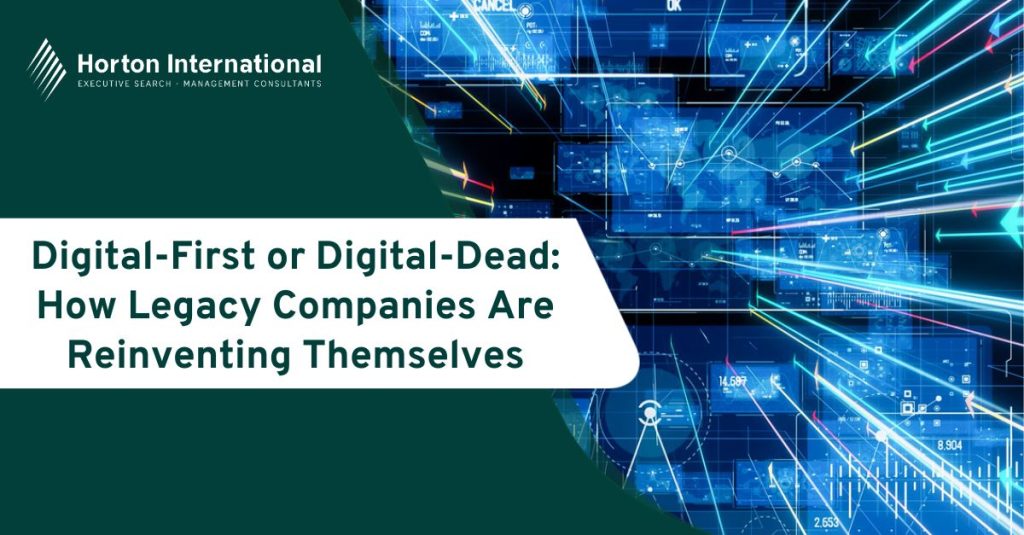The corporate graveyard is littered with household names that failed to see the digital tsunami coming. Today they’re best known as cautionary tales. Is your organisation likely to become another casualty?
Nearly four out of five business leaders say they know digital transformation will determine their company’s fate within 24 months. Yet 63% confirm their organisations are moving at glacial speed when it comes to actual change.[1] Tsunami versus glacier isn’t King Kong versus Godzilla – it’s wipeout time for ice. This gap between recognition and action has become the defining challenge of our era.
When CEOs Become Chief Transformation Officers
The companies emerging victorious share one trait: their leaders don’t just champion change; they personally architect it. These aren’t CEOs hiding behind consultants, rather they’re rolling up their sleeves and betting their careers on company modernisation.
At basic digitisation levels, leaders prioritise traditional industry disruption, smashing through bureaucratic roadblocks. They don’t just assign resources; they become the chief irritant officer, relentlessly pushing teams beyond comfort zones whilst painting vivid pictures of what will result from a digital first strategy.
Ambition is crucial – leadership involvement intensifies change, allowing employees to willingly abandon decades of established practices. In other words, leaders who succeed are orchestrating corporate rebellion against their own legacy systems.
The Great Cultural Uprising
Picture this: A century-old manufacturer where decisions always flowed top-down suddenly needs employees making data-driven choices in real time. The psychological whiplash is extraordinary, but the scenario is familiar: Covid 19. This cultural metamorphosis represented just one make-or-break moment for leadership legacy transformation.
The companies that survive don’t just change – they overthrow themselves. They systematically dismantle cultures built on certainty, replacing them with ecosystems that thrive on experimentation. Traditional companies must learn to celebrate brilliant failures whilst ruthlessly eliminating comfortable mediocrity.
The most successful transformations align money with mission. When executives tie leadership compensation to digital transformation success, suddenly every decision becomes viewed through the lens of digital progress. The transformation stops organisational reinvention being ‘someone else’s problem’ and becomes everyone’s opportunity.
Structural Revolution: Demolishing Silos, Building Networks
Traditional organisational charts look like medieval fortresses designed for defence rather than speed. Digital transformation requires destruction of those walls. Cross-functional teams replace departmental kingdoms, enabling lightning-fast decision-making that leaves competitors scrambling. It’s Robin Hood versus the Sheriff of Nottingham.
Smart legacy companies create dedicated digital units whose sole mission is reinvention. These teams operate with startup mentality inside corporate infrastructure, combining entrepreneurial speed with established resPicture this:ources.
Perhaps most cleverly, successful companies build optionality into their strategies. Instead of betting everything on single monolithic technologies, they create flexible architectures that can pivot toward whichever innovations prove valuable.
The Telkomsel Transformation: Digital David vs Goliath
After twenty-six years, Indonesia’s Telkomsel faced an existential crisis: how do you stay relevant when next-generation customers live entirely different digital lives?
The answer? Complete corporate reincarnation.
Telkomsel constructed a customer intelligence platform with over 9,000 data points per consumer, feeding 50+ analytical models monthly. This wasn’t just customer understanding; it was customer integration. As a result personalised services now generate half Telkomsel’s revenue.[2]
But data without new markets is merely expensive insight. How do successful companies overturn their original operations to become truly digital?
Telkomsel launched two brands: Orbit targeted connectivity-starved consumers, doubling customer acquisition goals with 20% monthly growth. By.U created a completely digital experience for Generation Z, smashing one-year goals in six months and reaching nearly 2 million subscribers.
The company torched its legacy app and constructed MyTelkomsel; a digital experience so compelling that monthly active users jumped tenfold to 24 million. Yet technology was only half the battle. Telkomsel recruited 40+ digital talents, created 12 new roles, and established seven agile squads operating with startup velocity inside their legacy telecoms stability.
Legacy Titans vs Digital Natives
The battlefield is asymmetric. Smart legacy companies discovered they didn’t need to become digital natives to defeat them. Instead, by creating hybrid organisms combining traditional strengths: customer relationships, regulatory expertise, operational scale, with digital capabilities they achieved growth in ways startup digitals can’t replicate.
The winning formula isn’t imitation – it’s integration. As the Telkomsel example shows, successful enterprises move quickly enough to remain competitive without sacrificing the trust and consistency that originally attracted their customer base.
Building the Forever-Evolving Enterprise
Digital transformation isn’t a destination – it’s a permanent state of being. Real champions in the C-suite establish cultures of perpetual reinvention, building sensing capabilities that detect opportunities whilst they’re whispers rather than shouts.[3] They become corporate shapeshifters, constantly adapting without losing essential identity.
The best transformations embed capabilities so deeply that they continue evolving, regardless of leadership changes. Such transformations develop internal champions and build transformation muscles that strengthen with use. Technology adoption leadership becomes the standard within the organisation rather than something brought in by consultants or a one-off focus to meet a limited need.
The Moment of Truth
The chasm between digitally-transformed legacy companies and traditional holdouts is becoming unbridgeable. Every month of hesitation widens the gap, every year of procrastination moves companies closer to irrelevance. And companies committing to comprehensive transformation don’t just survive, they dominate. They discover that combining decades of expertise with digital capabilities creates competitive advantages that pure digitals cannot replicate. They leverage their monolithic state so it’s streamlined to present a lean focused front, supported by massive legacy power.
In tomorrow’s economy, every company will be digital or it will be no company at all. In other words, the waters are receding fast – the precursor to the great wave that sweeps the unwary away. Legacy organisations face a choice, embrace transformation’s complexity or accept the certainty of being wiped out.
Sources
[1] https://sloanreview.mit.edu/projects/embracing-digital-technology/
[2] https://www.mckinsey.com/capabilities/mckinsey-digital/how-we-help-clients/how-telkomsel-transformed-to-reach-digital-first-consumers
[3] https://www.deloitte.com/us/en/insights/topics/business-strategy-growth/how-to-lead-digital-transformation.html






